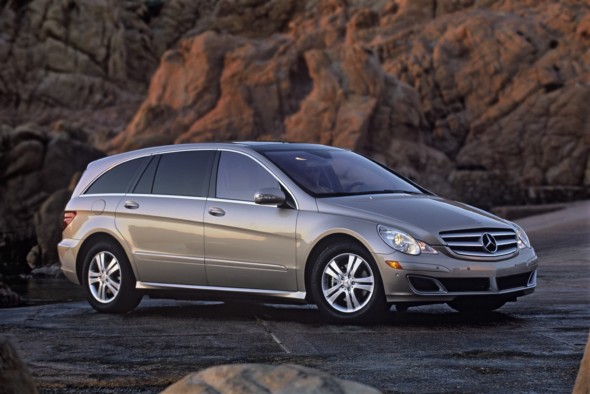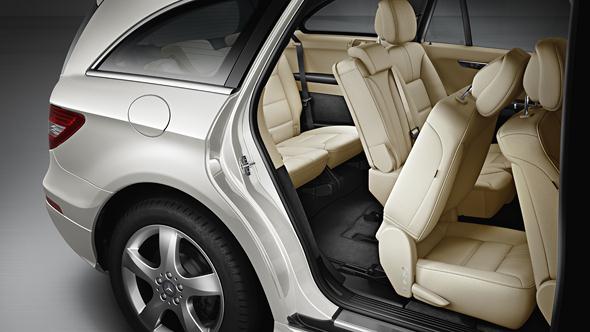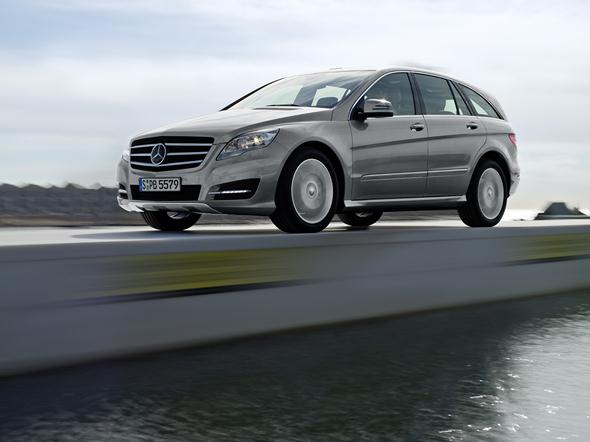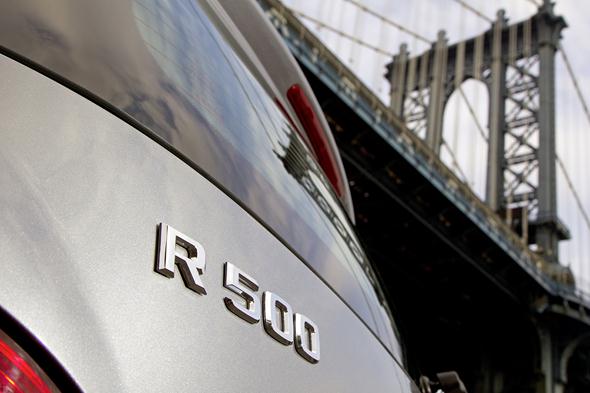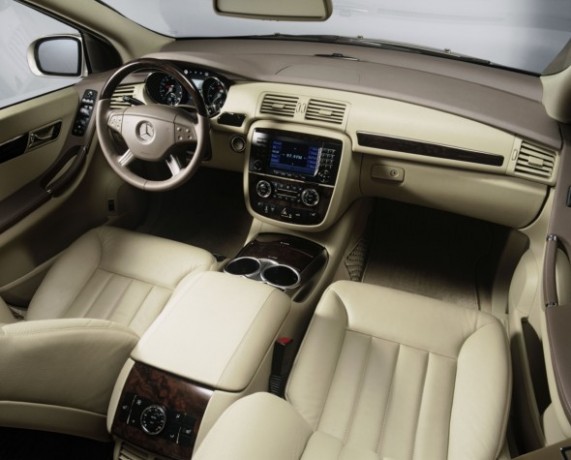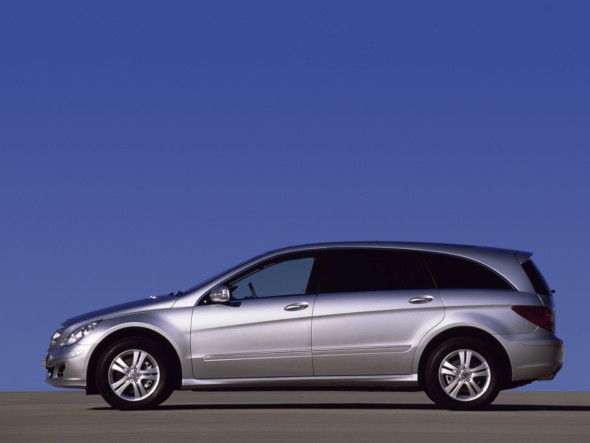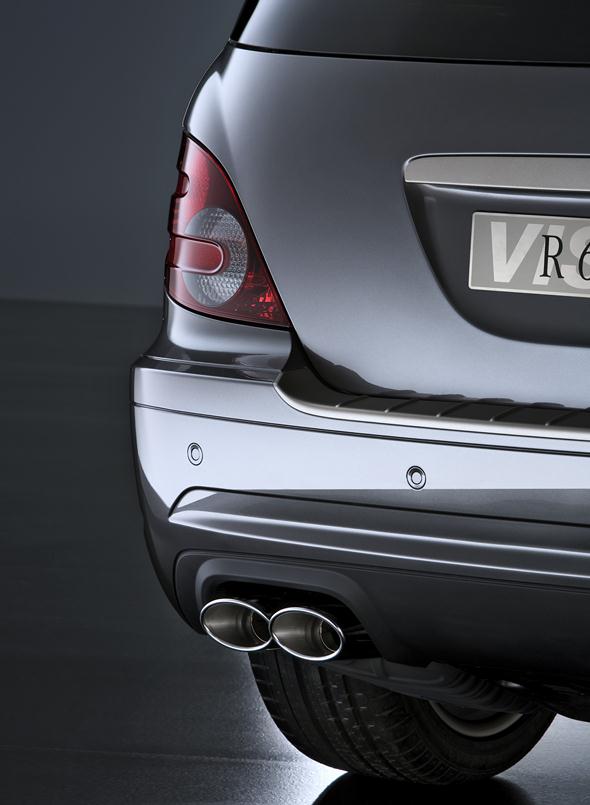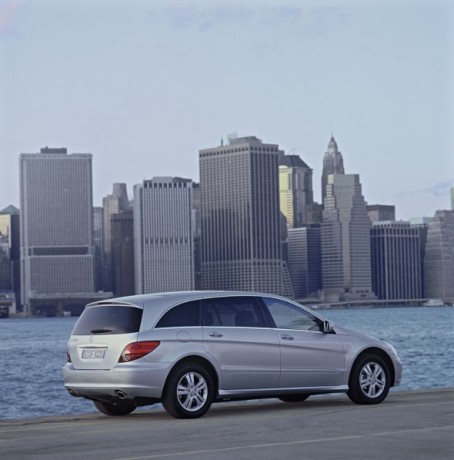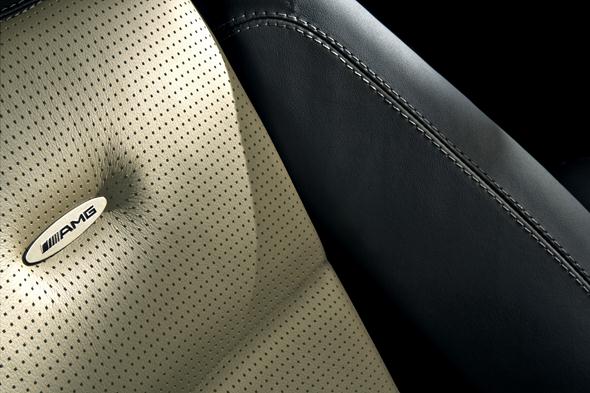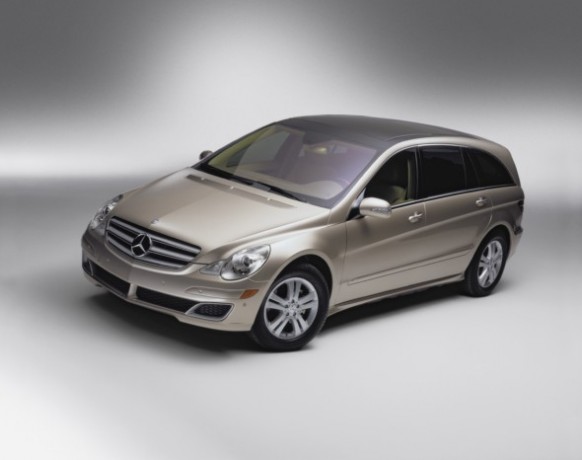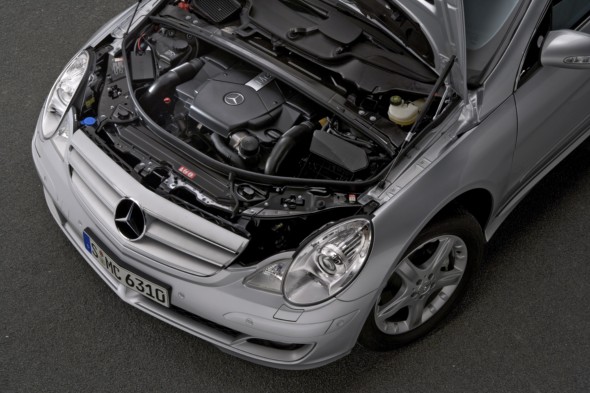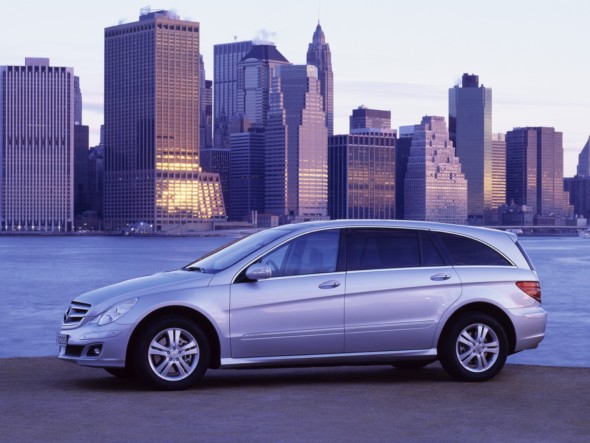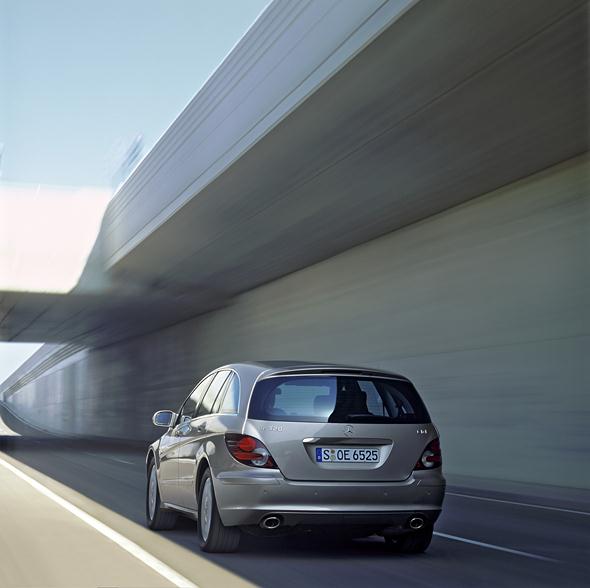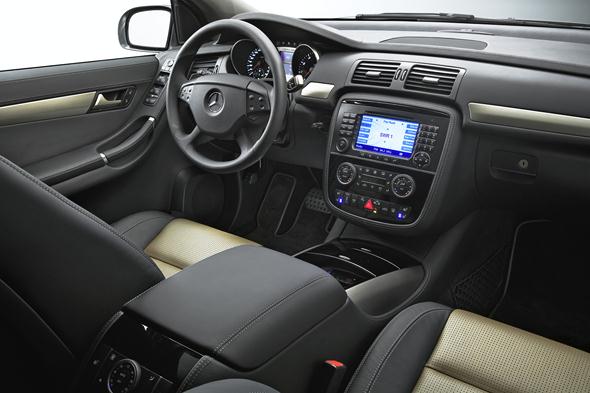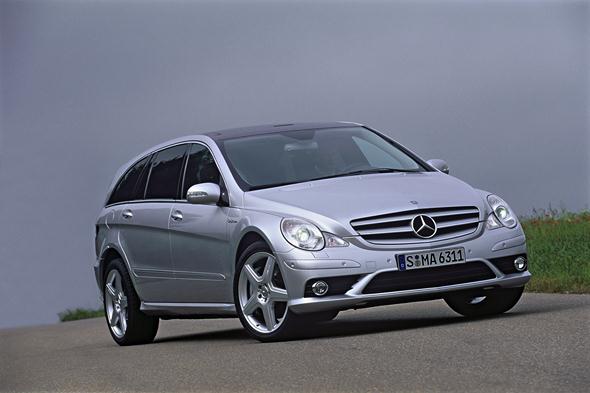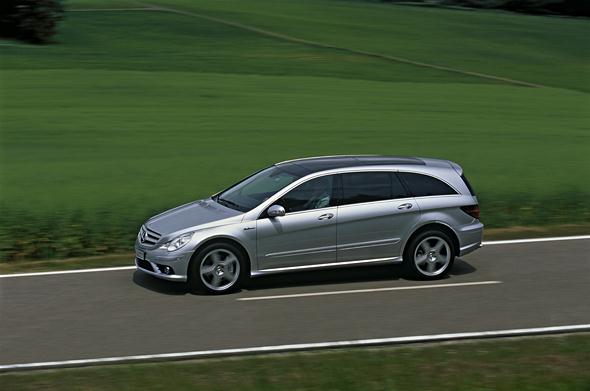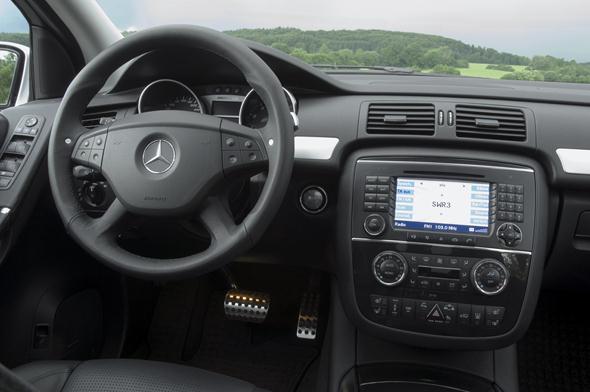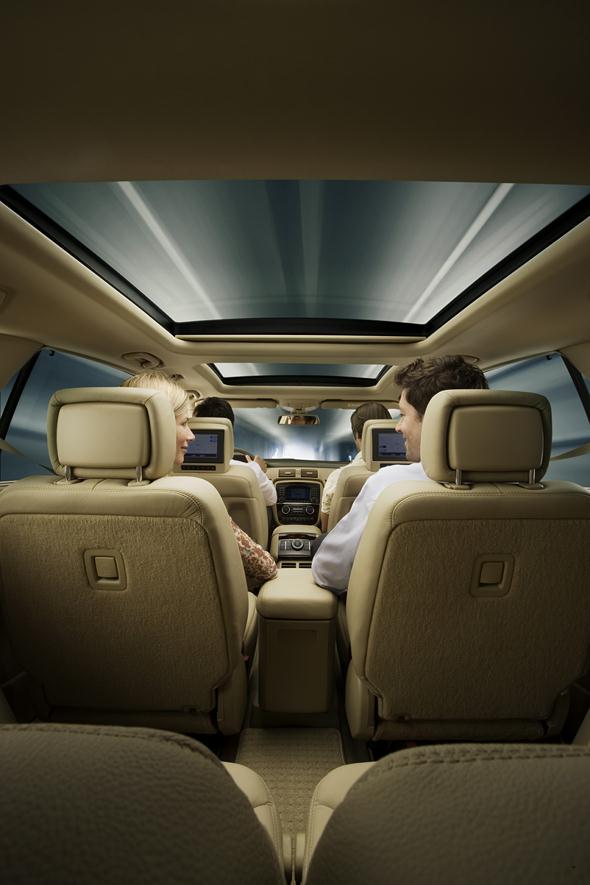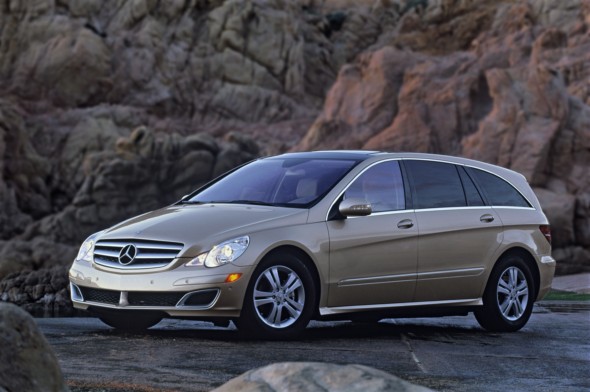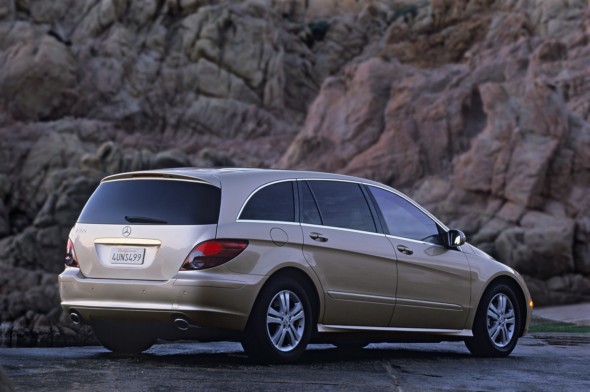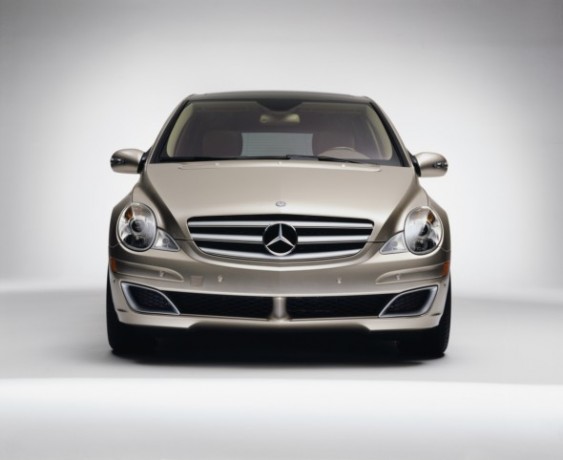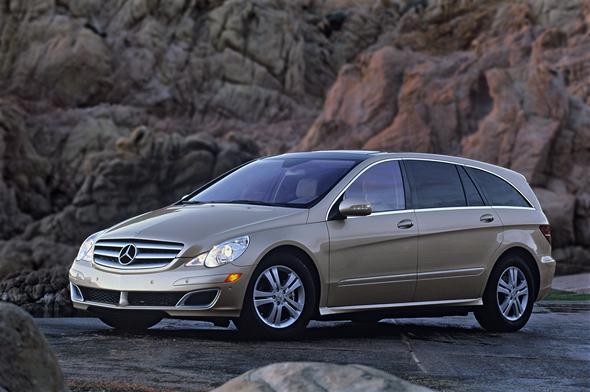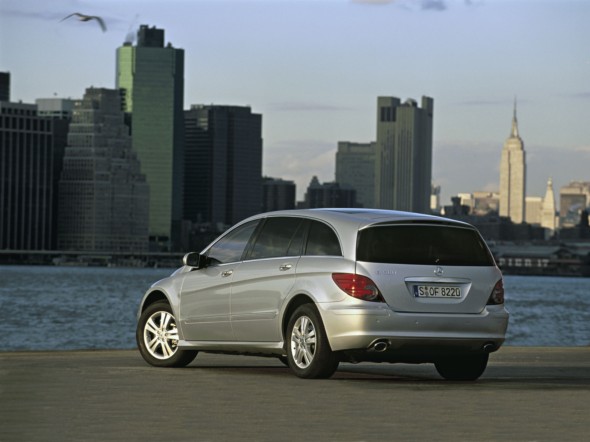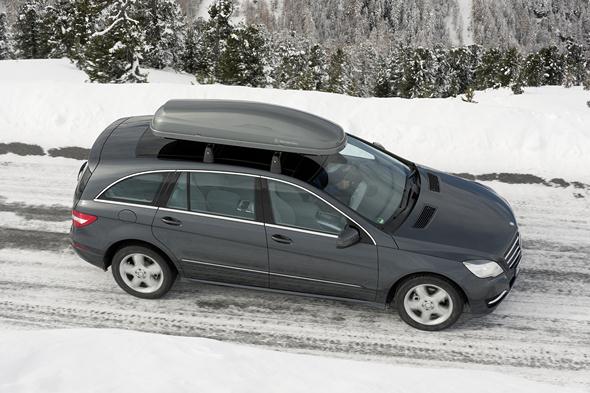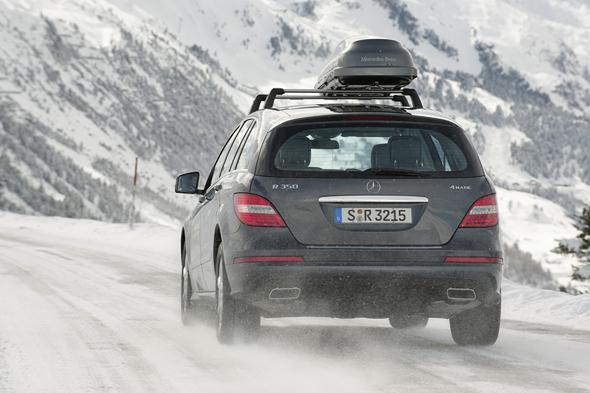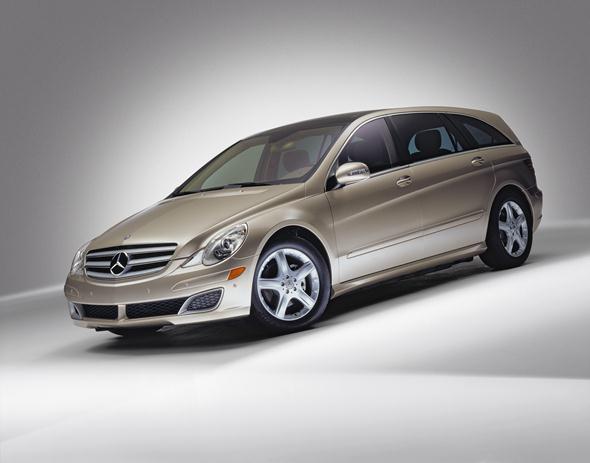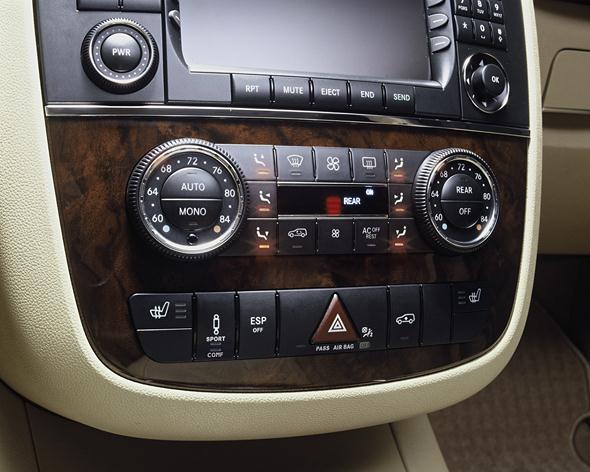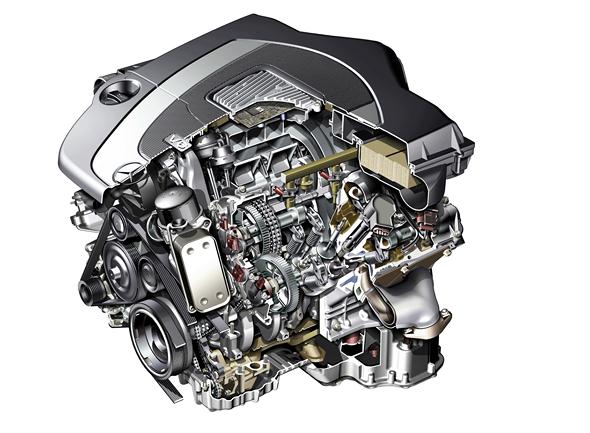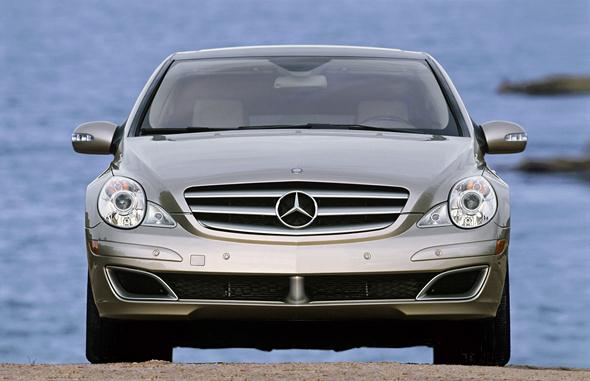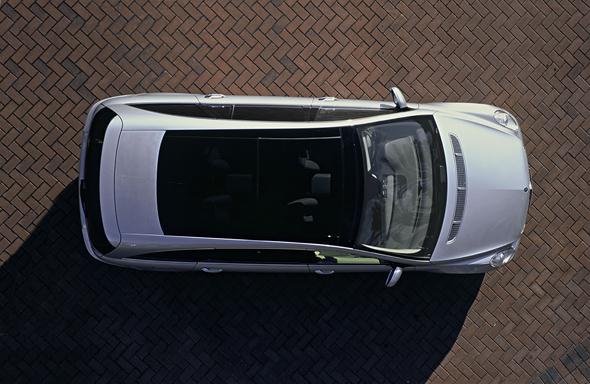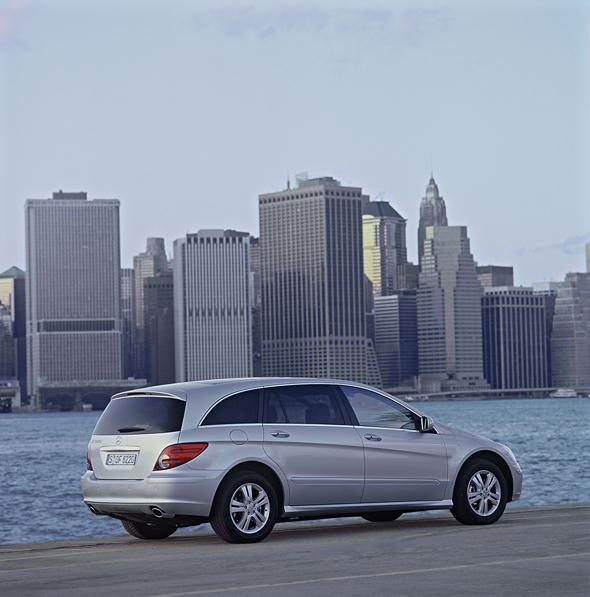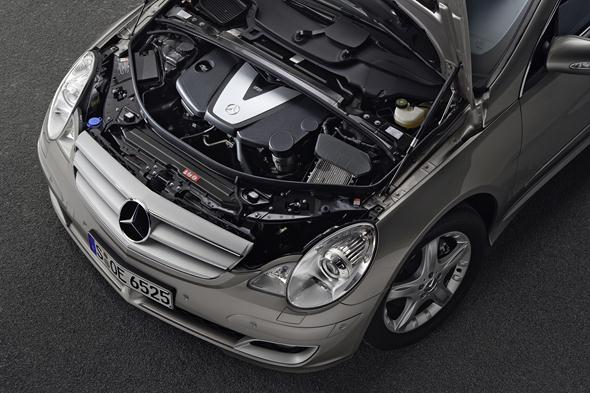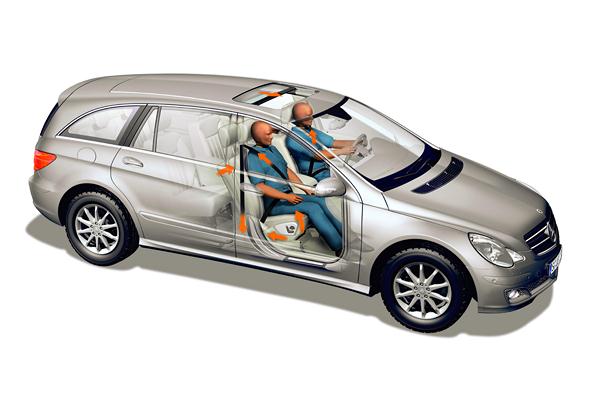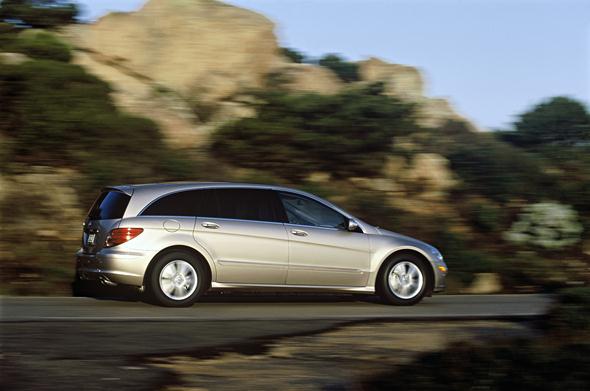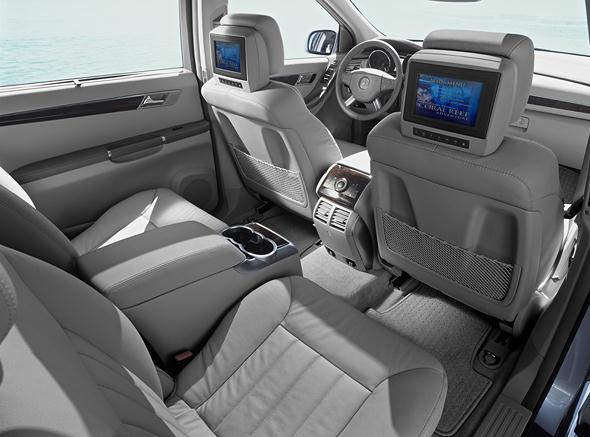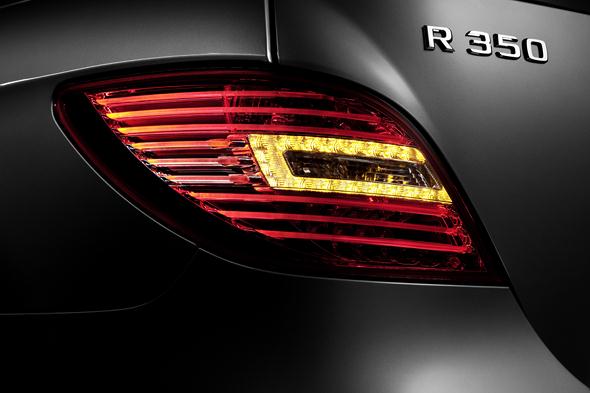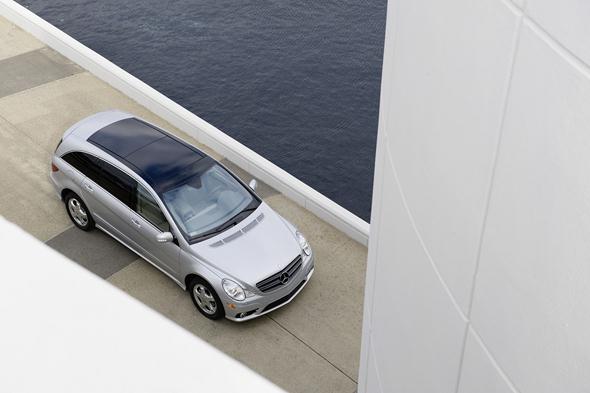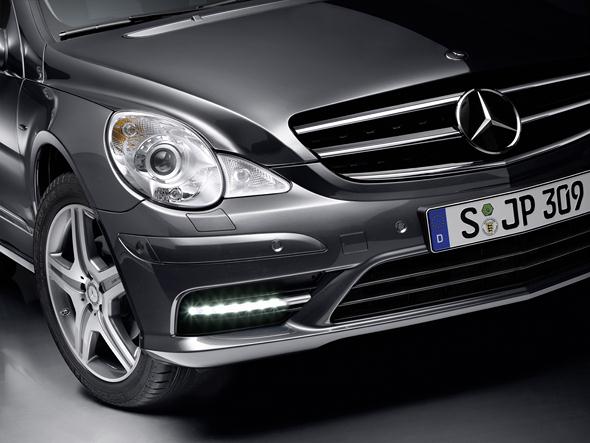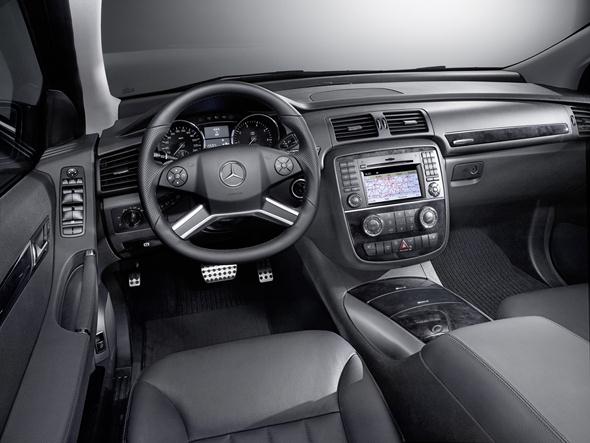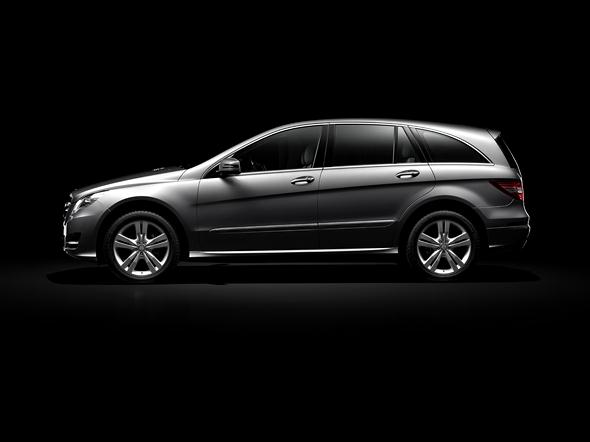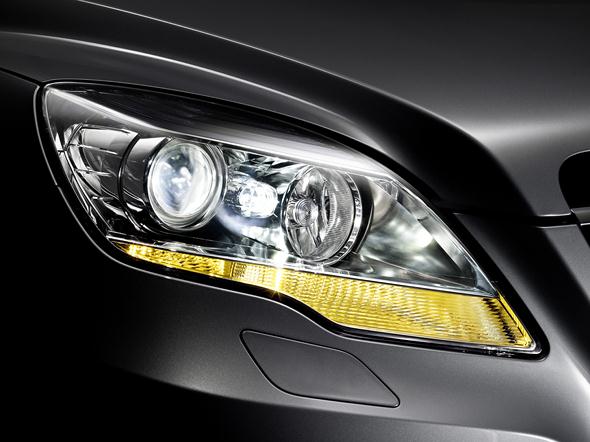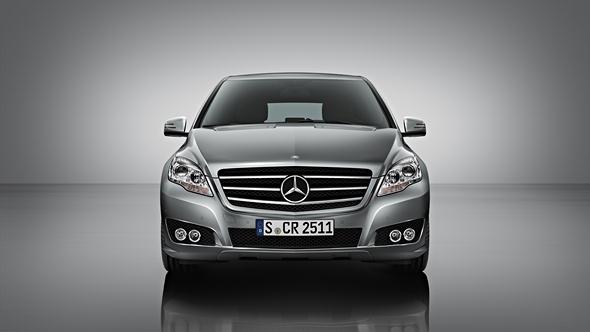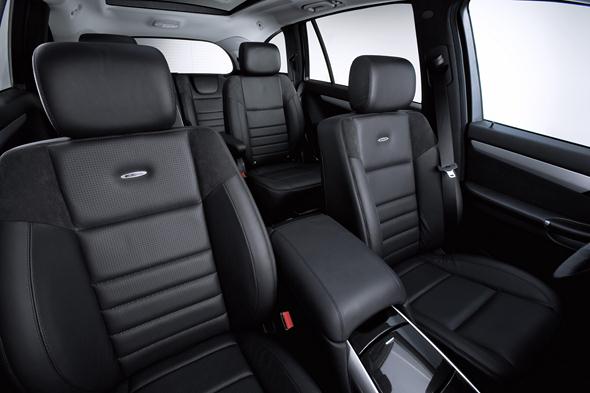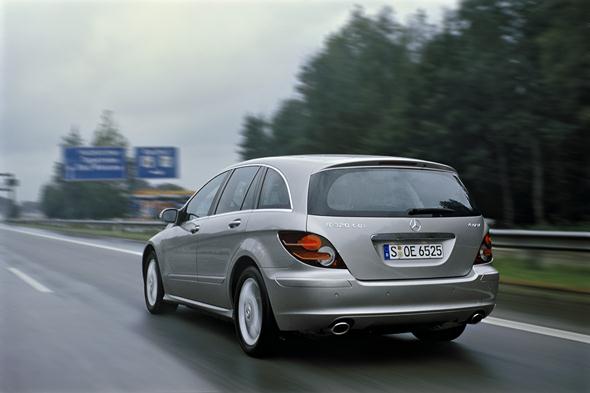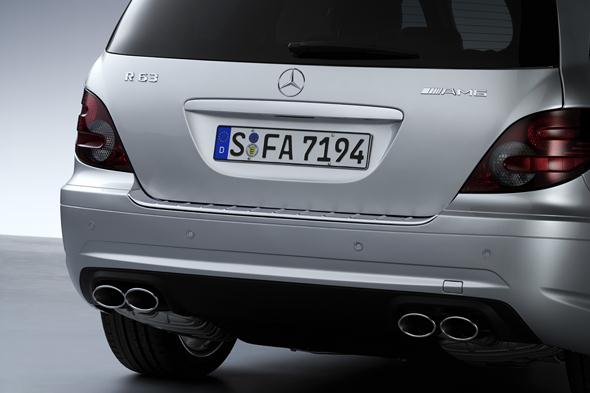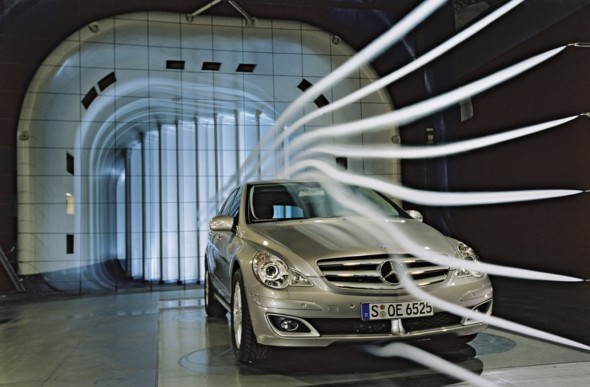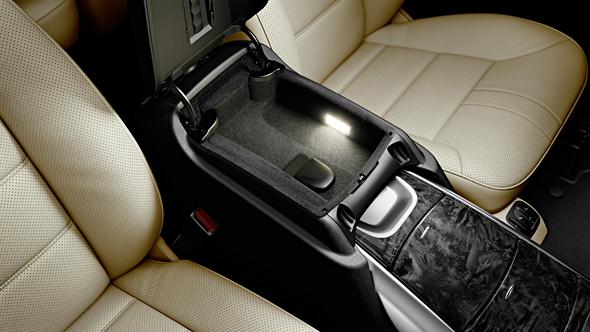- Generous levels of spaciousness and first-class comfort for 4+2 passengers
- Benchmark figures for seat spacing, headroom and shoulder room
- Luggage capacity of up to 2057 litres
- THERMATIC as standard, multi-zone THERMOTRONIC as on option
- DVD entertainment system for passengers in the rear
Modern-minded people want plenty of space, effortless motoring, an extremely high degree of flexibility and the ability to use it whenever they feel like it – and the Grand Sports Tourer comes closer than any other vehicle to offering them exactly what they are looking for.
Anyone seated in one of the luxurious individual seats is immediately treated to a memorable experience: an untrammelled experience of “space travel” on wheels.
This new standard in travel does not just stem from the “XXL” dimensions of the interior. The R-Class offers far more besides, courtesy of a harmonious blend of factors that produce an uplifting sense of wellbeing: the smooth-running V6 or V8 engines, the flawless climate control, the pleasant acoustics, the air-sprung chassis, the appealing colour scheme, the high-grade materials – just a few of the features which combine to make travelling aboard the R-Class an unforgettable experience.
The challenge faced by engineers at Mercedes as they strove to create a vehicle concept that genuinely broke new ground started as early as the dimensional concept stage.
The overriding question here was “How much car do six passengers need to enjoy Mercedes-class travel?”. The answer was a car with a two-box design measuring 5157 millimetres from front to rear.
This makes the R Class akin to a luxury saloon in size but considerably more spacious inside. Around 64% of its body length is dedicated to the occupants, a proportion that conventional body concepts are simply unable to match.
This exemplary economy of space maximises freedom of movement, at the same time forming a linchpin of the vehicle’s supreme long-distance comfort. Several of the interior measurements simply speak for themselves.
The seat spacing, one of the key indicators of freedom of movement and interior comfort, measures 920 millimetres between the first and second rows of seats in the standard position, a figure that is normally only associated with luxury saloons.
Between the second and third seat rows, up to 840 millimetres are available. Since the second-row seats are adjustable longitudinally, rear-seat passengers can enhance their own feeling of comfort still more, increasing the seat spacing between the first and sec-ond rows to 990 millimetres.
Headroom is another discipline in which the Grand Sports Tourer excels, with 1027 millimetres available in the second row and 946 millimetres in the rearmost row of seats.
The width measurements inside the R-Class also open up a whole new dimension in space and comfort. At 1550 millimetres in the front and 1562 millimetres in the rear, elbow width, for example, eclipses the figures for other luxury saloons by as much as 100 millimetres, representing a formidable result for the new vehicle concept.
Versatility is also high on the new model’s list of specialities: the individual seats in each of the rear rows can be folded flat separately as required, while the op-tional centre console can be removed completely, all in just a few simple steps.
Thus equipped, the interior is able to mould itself to changing space requirements or to the transportation task in hand, making light work of carrying mountain bikes, skis, snowboards or any other recreational equipment items, for example.
Even with a full contingent of six passengers on board, the R-Class still has enough space for a large golf bag behind the third row of seats.
With the rear seats folded down, the level load surface extends over a distance of 2217 millimetres measured from the front seat backrests to the tailgate.
The vehicle’s load capacity as measured using the VDA method also comfortably outstrips the figures for large estate cars, with a maximum of 2057 litres when loaded up to roof height (in accordance with the VDA measuring method).
Folding down just the third row of seats produces a luggage compartment with a maximum capacity of 977 litres. The seats can be rearranged to suit the current transportation task in just a few quick steps:
- The head restraints in the second row of seats are first pulled out and placed on the seat cushions. Then, the backrests are tilted forwards and the entire seat unit is pushed downwards.
- In the case of the third row of seats, the seat cushions are first raised to a vertical position, allowing the backrests to be folded forwards. The seat cush-ions can then be folded further forwards into a horizontal position. It is there-fore the reverse faces of the two rear rows of seats which together form the level load compartment floor.
The driver’s and front passenger seats both feature power controls for adjusting the height, seat cushion inclination and backrest angle. Their fore-aft adjustment range is 294 millimetres, allowing drivers of all statures to make themselves completely comfortable.
The standard-fit facility for adjusting the steering wheel’s height and reach serves to make doubly sure that all drivers are able to find the sitting position that is best suited to them.
The individual seats in the second row can also be manually repositioned fore and aft through a range of 150 millimetres, while the seats’ EASY ENTRY function makes it simpler for passengers in the rearmost row of seats to get into and out of the vehicle.
Anyone looking to customise seating comfort yet further is able to select from the following Mercedes-Benz optional extras …
- Electrically adjustable front seats with memory function for storing the seat, head restraint, exterior mirror and steering wheel settings
- Electrically adjustable sports seats with raised backrest bolster cushions and Alcantara/TWIN Leather upholstery for both driver and front passenger;
- Multicontour seats with inflatable air cushions and TWIN Leather upholstery for both driver and front passenger.
Forms, materials and ergonomics form a harmonious whole
It is not only the seating comfort in the R-Class that makes it such a pleasure to travel in, a host of further characteristics play a contributory role too, notably its aesthetic, tactile and ergonomic qualities.
The powerful design idiom of the body’s exterior, which stems predominantly from the striking contrast between its convex and concave-shaped surfaces, continues through into the interior of the vehicle.
The top section of the dashboard cuts a muscular line from one side of the vehicle right through to the other, signalling power and performance capability as it does so.
The two-tone interior colour scheme lends further emphasis to the pronounced crossways effect: the dark tone used for the dashboard, armrest and door panels forms an appealing contrast with the lighter tone variant sported by the remaining interior components.
The tactile qualities are every bit as impressive too, thanks to the use of high-grade materials such as the fine leather on the armrests, the soft plastic surface of the dashboard, the aluminium or fine-wood trim and the switches in the centre console, whose faces gleam with a special “soft-touch” coating that has a particularly pleasant feel.
One of the most eye-catching features is the instrument cluster, whose large, round dials protrude from circular cylinders that are angled slightly inwards, while the black faces are a nostalgic touch that recalls the design of classic, high-precision chronographs.
The left-hand cylinder houses the speedometer and clock, whilst the cylinder on the right keeps the driver informed of rev speed and fuel level.
The various red and yellow indicator lamps that are distributed over the surface of the two dials only ever make their presence known when the engine is started or they are prompted to light up.
Nestling in-between the two dials is a split central display, showing the distance travelled at the top and the current drive mode, selector lever position and outside temperature at the bottom.
At the press of a thumb, the buttons in the standard-fit multifunction steering wheel give drivers control over the stereo system and car phone, as well as allowing them to call up important information, which again appears in the instrument cluster’s central display.
This also provides a convenient means of programming individual settings, covering everything from the digital km/h display and activation of the automatic central locking to setting the speed limit for winter tyres.
Once these settings have been made, they remain permanently activated and require no further intervention on the part of the driver.
The Mercedes engineers have made the interior door trim an integral part of the operating concept, too, incorporating into it the controls for the standard-specification power windows, the exterior mirror adjustment and the remote tail-gate release (driver’s door).
The units and controls in the centre console are arranged in accordance with ergonomic principles, with the relative importance of the functions, the frequency with which they are used and visual considerations taking priority.
Consequently, the car stereo system or navigation system, depending on the model’s specification, is located in the topmost position, where it is within easy reach of the driver.
Below this can be found the control panel for either the THERMATIC automatic climate control system that is fitted as standard or for the optional multi-zone THERMOTRONIC system, with both units featuring ergonomic, attractively styled rotary controls for manually adjusting the temperature (right).
Rounding off the centre console at the bottom is an array of buttons for controlling various functions.
Dispensing with a conventional automatic transmission selector lever in favour of the brand new DIRECT SELECT gearshift on the steering column has made way for a roomy stowage compartment and a cup holder in the transmission tunnel covering of the R-Class.
Both are concealed beneath covers which gently open when light pressure is applied.
The padded armrest between the front seats also conceals a spacious stowage compartment, with a special section at the top where a mobile phone can be installed. The back of the transmission tunnel covering features two individually adjustable air outlets for the rear compartment.
Audio 20 car radio system with CD player fitted as standard
The Grand Sports Tourer rolls off the production line equipped with the Audio 20 stereo system as standard, ensuring excellent in-car entertainment and pure musical listening pleasure. It features an FM/MW/LW/SW tuner combined with an integral CD player.
The unit also boasts a keypad which can be used to enter phone numbers when it is networked with a car phone or mobile phone.
There is a choice of two optional combined tuner and navigation systems for the new R-Class:
- The Audio 50 APS unit comprises a twin FM tuner, CD player, TFT colour display and arrow-directed navigation. The integrated CD player can continue to play audio CDs whilst navigation is in progress. All other radio and control functions are identical to the Audio 20 unit.
- The hallmark feature of the COMAND APS system is its large 6.5″ colour display featuring state-of-the-art TFT technology. A full-colour map assists with route guidance. Once the route has been computed, the navigation DVD can be removed to allow audio CDs to be played, in which case the navigation system will issue its instructions in the form of arrows. Radio reception is taken care of by a twin FM RDS tuner which is also able to receive LW, MW and SW stations.
All of the Mercedes car radio systems include a speed-sensitive volume control: above a speed of around 20 km/h, the volume is raised in increments to compensate for the increase in background noise.
An antenna diversity function, which ensures optimum reception by selecting the strongest signal from the roof aerial and the two FM aerials in the rear window, also makes up part of the standard package.
Sound system and DVD system for superlative in-car entertainment
The Mercedes car stereo systems channel their output through a total of eight speakers as standard. An even more sophisticated set-up is available in the form of a surround sound system boasting eleven speakers in all, plus an extra sub-woofer.
The system has been custom-designed to suit the interior’s acoustics: a microphone monitors current noise levels, enabling a microcomputer to adapt the volume and sound accordingly to ensure uninterrupted high-fidelity listening.
A six-disc, MP3-compatible CD changer which is housed in the glove compartment may also be specified as an option in conjunction with the Audio 20, Audio 50 APS and COMAND APS systems.
A further equipment option allows passengers in the rear to enjoy the freedom of compiling their own audio or video entertainment programme.
The Rear-Seat Entertainment package comprises two colour screens with earphone connections which are incorporated into the backs of the front-seat head restraints, along with a CD/DVD player which is accommodated in the rear centre console.
There is also a facility for connecting external audio/video devices or a games console.
Choice of two sensor-regulated air conditioning systems
Climate control for such a spacious interior as that in the R-Class is reliant on powerful technology. Mercedes engineers have devised two different systems which are designed to offer supreme passenger comfort:
- In standard specification, the R-Class comes equipped with the THERMATIC system that provides dual-zone interior climate control.
- Customers may also opt for the multi-zone THERMOTRONIC system which permits individual temperature settings to be made for three separate zones: for the driver’s side, for the front passenger side and for the passengers in the second row of seats in the rear.
The multi-zone THERMOTRONIC system can in turn be expanded by the addition of a rear air conditioning unit for the third row of seats. This unit is concealed in the rear behind the left-hand sidewall panelling.
Both systems have been adapted to take account of the generous interior dimensions of the new R-Class, resulting in exemplary efficiency. They are equally as capable of cooling down the interior quickly on hot summer days as they are of keeping passengers snug and warm in the depths of winter.
The automatic climate control’s maximum heating capacity, for example, as measured in accordance with test specifications in ambient air that has been cooled down to minus 20 degrees Celsius and at a coolant temperature of 80 degrees Celsius, is ten kilowatts.
To put this figure in perspective, it roughly equates to the capacity of a modern central heating system in a detached house.
On the R 320 CDI diesel-powered model, the effect of the heater core is boosted at low outside temperatures by an electrical PTC (Positive Temperature Coefficient) heating element with a heating capacity of 1.7 kilowatts.
The PTC’s additional heating power is required as a result of the six-cylinder CDI engine’s outstanding thermal efficiency, which has an extremely positive impact on fuel consumption but results in far less heat being dissipated to the coolant at partial throttle than is the case with many other engines.
Sensors regulate operation of the THERMATIC automatic climate control system to take account of temperature changes and levels of direct sunlight.
The system is controlled by a network of nine sensors in all: seven outflow pickups in the air outlets monitor the temperature of the air as it enters the interior, one sensor in the control panel records the interior temperature and a solar sensor on the dashboard relays data on the intensity of the sunlight and its angle of incidence.
This provides all the information that is required to compare the passengers’ desired settings with the actual readings and adjust climate control accordingly.
This means that in automatic mode, the temperature, blower speed and air distribution are permanently regulated in such a way that the temperatures set by the driver and front passenger are faithfully maintained once they have been reached.
At high ambient temperatures, for example, the automatic climate control is also capable of varying the proportion of recirculated air: this has the dual effect of cooling down the passenger compartment more rapidly and of minimising the re-quired cooling output.
To keep THERMATIC running as economically as possible by adapting its operation to current requirements, the powerful air conditioning compressor is able to adjust its output smoothly. This is done by means of a solenoid valve which varies the compressor’s swept volume.
The driver and front passenger are each able to select their preferred temperature using stylish rotary controls. Red LEDs indicate the temperature settings. The right-hand control also includes buttons for activating the rear compartment ventilation and residual engine heat utilisation functions.
In the centre of the panel between the two temperature controls can be found buttons for manually setting the blower speed, switching on the defrost function, the heated rear windscreen and air recirculation mode, as well as for altering the air distribution settings.
Passengers seated in the second row benefit from their own control panel. Located on the rear of the transmission tunnel, it allows air distribution to be adjusted individually for each of the second row seats.
Multi-zone THERMOTRONIC with booster blower for the rear
The optional multi-zone THERMOTRONIC system offers an even higher standard of climate comfort, which is especially of benefit to passengers in the rear.
To achieve this, Mercedes-Benz devised the principle of three-zone climate control, whereby the occupants in the second row of seats are able to select their own temperature, airflow and air distribution settings independently of the driver and front passenger.
This is all made possible by the inclusion of an auxiliary booster blower in the transmission tunnel covering, which permits virtually autonomous control over the airflow in the rear.
A team of eleven probes keep the multi-zone THERMOTRONIC system’s micro-computer fed with up-to-the-minute readings: the seven outflow temperature pickups in the air outlets, the central temperature sensor in the control panel and the solar sensor are joined by a dew-point sensor whose air humidity readings are also used to automatically regulate climate control.
Finally, the multi-zone THER-MOTRONIC system in the new R-Class also comes equipped with a pollutant sensor which monitors levels of carbon monoxide and nitrogen oxides in the outside air.
If the concentration of pollutants becomes too high, the air conditioning automatically switches over into air recirculation mode.
In the system’s fresh air mode, an activated charcoal filter works to absorb pollutants and reduce the intensity of any unpleasant odours penetrating the passenger compartment.
LEDs in the stylish rotary controls on the front of the multi-zone THERMOTRONIC control panel keep the driver and front passenger informed of the current temperature settings.
The “Mono” button in the left-hand control enables the settings for both the driver’s and front passenger side, as well as for the rear, to be synchronised and temperature selection to be controlled centrally using the left-hand rotary control.
Computational thermal and flow models had a key role to play during the development of this highly complex and efficient system. With the aid of these models, the engineers at Mercedes were able to investigate the effectiveness of a number of ideas and to optimise the concepts long before initial prototype testing was carried out.
The question of how large to make the air outlets and where to best posi-tion them formed a focal point of the development work.
The end result is a bat-tery of up to 18 air outlets, which are incorporated into the dashboard, the foot-well, the transmission covering and the B-pillars.
Electric motors in the interior of the air conditioning unit regulate the airflow based on either the manual settings or – in automatic mode – based on a computer program.
Apart from the large defroster outlet directed towards the front windscreen, four further air outlets have been stylishly integrated into the dashboard which the driver and front passenger can adjust individually; they have a swivelling design and include thumbwheels for reducing the airflow as required.
A floor-level outlet together with two swivelling and adjustable outlets in the transmission tunnel take care of supplying air to the rear.
Additional swivelling air outlets which are directed towards the rear passenger compartment are incorporated into the inte-rior B-pillar trim on R Class models which leave the factory equipped with multi-zone THERMOTRONIC.
Body and safety: Safe and secure
- Body structure with crash boxes and large safety zones
- Belt buckle tensioners and belt force limiters for all occupants
- PRE-SAFE® and crash-responsive NECK-PRO head restraints on request
- Unique panoramic sliding roof with two large areas of glass
Passive safety, long-term durability, comfort, lightweight construction – to meet these and other stringent Mercedes requirements the engineers in Sindelfingen developed a unitised bodyshell structure of which half comprises high-strength and very-high-strength steel alloys.
These absorb severe forces during an impact and offer outstanding torsional rigidity. Accordingly the bodyshell provides an important basis for handling safety, ride comfort and dynamic performance.
Moreover, the latest production and design processes ensure the long-term quality which is so typical of a Mercedes bodyshell.
One example is the low-stress joining technology: the flanges at the edges of the steel body components are designed so that any tolerances are compensated when the steel sheets are positioned, enabling them to be welded together with minimal internal stresses.
This process improves the dimensional accuracy of the bodyshell.

Mercedes-Benz also uses fully-galvanised panels in all areas of the bodyshell, some of which have an additional organic coating depending on their location. This coating also contains rust-inhibiting zinc pigments.
Highly vulnerable areas of the body are additionally protected with a cavity-fill preserving agent, and the welding flanges are carefully weather-sealed.
Using plastic for a large area of the multi-part underbody panelling, which protects against stone chippings, water and soiling, has allowed Mercedes engineers to dispense with conventional PVC underseal.
And finally the new R-Class also shines with an innovative, more scratch-resistant clearcoat employing on nano-technology, with which Mercedes-Benz has achieved significant progress with respect to long-term quality and value retention.
This innovative paint system is used as standard for metallic and non-metallic finishes.
Front and rear-end modules can be replaced without welding
Ease of repair was another Mercedes requirement during bodyshell development, and the tried-and-tested modular concept made an important contribution in this respect: the front and rear-end modules are bolted to the body structure, and can therefore be replaced without troublesome welding work during accident repairs.
The front-end module basically consists of a robust aluminium cross-member which is not only used to attach the front bumper, but also has a major task during an offset frontal collision in directing impact energy to the unaffected side of the vehicle, where it is dissipated.
Two crash boxes of high-strength steel are connected to the front longitudinal members and together with the aluminium flexural member, absorb a large proportion of the impact energy during frontal collisions up to 15 km/h.
The downstream structure remains unaffected by the crash as a result. The highly resistant longitudinal members are only activated at high impact speeds (more than 15 km/h) to provide a crumple zone.
During an offset crash the second level of longitudinal members above the wheel arches forms an additional energy-absorption path.
The integral member of high-strength steel to which the front axle, steering gear, engine and front axle differential are attached likewise deforms during a severe frontal collision and absorbs crash energy.
The main floor consists of three assemblies which form a robust structure in combination with additional cross-members. The centre floor area is designed as a tunnel which forms the backbone of the main floor, and therefore of the entire body structure.
The two outer assemblies in the floor are reinforced with cross-members which both provide a solid base for the seats and also ensure a high level of transverse strength, which particularly benefits occupant protection during a lateral collision.
In addition, a diagonal member extending from the firewall to the area of the B-pillar strengthens the main floor.
In conjunction with the floor panels the pillars, side members and sidewalls make up a highly robust safety zone for the vehicle occupants.
The sidewall structure is of three-layered construction; in the interests of occupant safety the nodal points between the pillars, roof frame and side members are specially reinforced. The three-skinned A-pillars are supported by cross-members at several levels.
Crash boxes and strong sections absorb energy during a rear-end impact
As at the front end, easily repaired steel crash boxes and an aluminium flexural member are used at the rear end. These components absorb energy in the event of minor collisions with impact speeds up to 15 km/h, so that the downstream body structure remains undamaged.
Bolted connections allow the inexpensive replacement of damaged crash boxes and the cross-member. The rear box-section side members of the new R-Class are designed as continuous, closed sections with gradually diminishing material thicknesses, and contribute substantially to occupant safety during a rear-end collision.
The spare wheel recess is of steel, while the fuel tank is located in front of the rear axle where it is protected from impacts.
Airbags and belt force limiters work adaptively according to accident severity
With two-stage front airbags and belt force limiters (front), belt-buckle and inertia-reel tensioners, as well as sidebags and windowbags, the R-Class also meets the high Mercedes standard where occupant protection systems are concerned.
The sensors for the restraint systems include two up-front sensors on the front module whose remote positioning in the front end of the body enables them to detect the severity of a collision even earlier and with greater accuracy than the central crash sensor on the centre tunnel.
This makes it possible to shorten the time that elapses between the moment of impact and the deployment of the airbags and belt tensioners even further.
Moreover, these sophisticated sensors make it possible to control the pyrotechnical belt force limiters on the front seats adaptively, and to deploy the airbags in two stages depending on the accident situation.
During a minor frontal impact the electronic control unit only ignites one stage of the two-stage airbag gas generators, and the airbag inflates more gently.
Should the control unit detect a severe frontal collision, however, it deploys the second stage of the gas generator after a slight delay. As a result, the airbags are inflated to the maximum to provide the occupants with the level of protection required in a collision of this severity.
The belt force limiters for the driver and front passenger are also adaptive, i.e. they operate according to the accident situation: if the sensors send information that a frontal collision is severe, the seat belts are tensioned and reach their maximum retaining power.
Shortly afterwards the force limiters switch to a lower level of force, which slackens the belts slightly and allows the front occupants to sink more deeply into the airbags. This reduces the loads acting on the chest area.
Crash-responsive head restraints reduce the risk of whiplash injuries
Newly developed NECK-PRO head restraints (optional) optimise protection for the driver and front passenger during a rear-end collision.
They are likewise linked to the control unit: if the sensor system detects a rear-end collision with a defined impact severity, it releases pre-tensioned springs inside the head restraints which immediately cause these to move forward by about 44 millimetres and upwards by 30 millimetres.
This means that the heads of the front occupants are supported at an early stage, reducing the risk of whiplash injuries. After NECK-PRO activation the head restraints can be unlocked and returned to their original position using a tool supplied with the car.
Sidebags and windowbags with complementary protective functions
With standard-fitted sidebags for the driver and front passenger, as well as windowbags, the restraint system of the new R-Class provides two further, highly-effective systems whose protective effect is complementary: while the sidebags primarily reduce the loads acting on the chest area, the windowbags provide head protection over a wide area for both front and rear occupants.
During a lateral impact the windowbag inflates and extends from the front to the rear roof pillar like a large curtain. Accordingly it also gives protection against objects which might penetrate into the vehicle interior during a crash.
A special sensor system is responsible for deployment of the sidebags within milliseconds: in addition to the central sensor in the interior, satellite sensors located near the base of each B-pillar provide information about the severity of a lateral collision.
The sophisticated crash sensor system in the new R-Class is rounded off by a roll-over sensor which activates the belt tensioners and windowbags in the appropriate situation.
PRE-SAFE® gives the R-Class “reflexes” which respond before an impending accident
Mercedes-Benz has also achieved a remarkable advance in the field of safety with the anticipatory occupant protection system PRE-SAFE®, which already becomes active during the seconds preceding an impending accident. PRE-SAFE® is available as an option for the new R-Class.
The system creates the link between active and passive safety. It is networked with Brake Assist and the Electronic Stability Program (ESP®) and recognises critical handling situations which might lead to an accident.
PRE-SAFE® intervenes in such dangerous situations within milliseconds, preparing both the occupants and the vehicle for the possible collision:
- The seat belts of the driver and front passenger are tensioned as a precaution.
- If the electrically adjustable front passenger seat with memory function (optional) is adjusted to an unfavourable fore-aft setting or cushion/backrest angle, it is moved to a better position.
- The sunroof is closed if there is a risk of the vehicle rolling over.
Thanks to these precautionary PRE-SAFE® measures the vehicle occupants are in a better seating position even before the accident occurs, enabling the seat belts and airbags to work more efficiently.
If the accident is avoided, the preventive tensioning of the seat belt is automatically relaxed and the passengers are able to return the seat and sunroof to their previous positions.
The occupant protection systems of the new R-Class at a glance:
| Front seats | Rear seats |
| Inertia-reel seat belts | o | o |
| Belt tensioners | oBuckle-type tensioners | oInertia-reel tensioners |
| Belt force limiters | oAdaptive | o |
| Head restraints | oAdjustable for height and angle, optional crash-responsive NECK-PRO head restraints | o |
| PRE-SAFE® | Optional | — |
| Front airbags | oWith adaptive control | — |
| Sidebags | o | Optional for the second seat row |
| Windowbags | o |
| Automatic child seat recognition | oIn front passenger seat | — |
| ISOFIX child seat attachments | — | o |
Front passenger detection
o = Standard
Exemplary aerodynamics improve handling stability and economy
With long experience and painstaking attention to detail, Mercedes engineers have developed the bodyshell of the Grand Sports Tourer to ensure that it also scores top marks in terms of wind resistance, lift and wind noise.
The aerodynamically efficient shape of the front and rear ends, the smooth underbody panelling, the effective sealing around the radiator grille and a host of other measures ensure that despite its body size, the R-Class achieves a coefficient of drag (Cd) matching that of an up-to-date estate car: 0.31.
Another major contribution to fuel economy and improved handling stability is made by the AIRMATIC air suspension system (optional). This automatically lowers the suspension by 20 millimetres at 140 km/h and thereby reduces drag by more than three percent.
The aerodynamics specialists have also optimised handling stability, braking characteristics and directional stability with measures which reduce the lift at the front and rear axles.
These include the small spoilers in front of the wheels, the rear apron with a special diffuser or the underbody panelling extending from the engine compartment to the rear axle.
Accordingly the R-Class achieves outstanding coefficients of lift which at the rear axle, for instance, are below the level for luxury saloons.
Key aerodynamic figures for the Grand Sports Tourer at a glance:
| R-Class |
| Cd value | 0.31-0.32 |
| Frontal area (A) | 2.74-2.76 |
| Wind resistance Cd x A | 0.85-0.88 |
| Front axle lift cFA | 0.03 |
| Rear axle lift cRA | 0.08 |
Sophisticated aero-acoustic development ensures high noise comfort
Research in the wind tunnel not only affects fuel consumption and handling safety, but also the level of comfort experienced by the vehicle occupants – the noise comfort or aero-acoustics.
The advances achieved in this field are especially audible (or rather, less audible) in the new R-Class.
The A-pillars were a particular focal point; these were painstakingly optimised to ensure that disturbing wind noise is hardly perceptible for the occupants.
For the doors, care was taken to ensure that the outer and inner skins formed a rigid, vibration-resistant structure by virtue of various reinforcing sections, and that the window frames in particular are extremely robust.
In this way airstream-induced movement of the window frames at high speed was significantly reduced. In addition the door edges feature a continuous double seal – and in some areas even a triple seal – to ensure that no wind noises are audible.
For the large panoramic sliding sunroof the acoustics specialists developed an innovative, vaned wind deflector which both prevents thrumming when the roof is open and protects the occupants against annoying draughts.
As soon as the roof is opened, the wind deflector is automatically raised but retracts by twelve millimetres when the airflow reaches a certain level, reducing the wind noise and draught entering the interior.
The tilting/sliding sunroof is also fitted with a wind deflector whose notches create a linear turbulence which effectively suppresses thrumming.
Exterior mirrors and side windows remain clean in the rain
The fact that the exterior mirrors and side windows remain clean and do not obscure the driver’s view in the rain is also due to the work done in the wind tunnel. Mercedes engineers achieved this by directing the rainwater to the rear, downwards or to the sides.
Rainwater striking the windscreen is collected in drainage channels on the A-pillars, then conducted to the rear along the roof with the help of the slipstream and drained away downwards by a channel at the rear edge of the roof.
The housings of the exterior mirrors are designed in such a way that rainwater flows to the outside along an unobtrusive, continuous channel and drains away.
Aero-wipers improve visibility for the driver
The windscreen wipers of the new R-Class were also developed in the wind tunnel: they are known as aero-wipers.
Instead of the articulated retention system used for conventional wiper blades, in which the rubber blades are claw-mounted, the aero wiper consists of a one-piece rubber section with an integral spoiler and externally mounted spring rails; these precisely follow the curve of the windscreen.
The spring rails ensure an even distribution of wiper pressure along the entire length of the wiper blade, so that it always operates with the greatest possible contact pressure. The result is significantly better wiping quality, even in heavy snow.
Dispensing with the conventional claw-mounted system, which is prone to icing in winter conditions, reduces the overall height of the wiper blade by almost half. This produces a noticeable reduction in windscreen wiper noise.
The new R-Class is equipped with an efficient two-arm wiper system with special kinematics: while the driver’s-side wiper arm moves around a fixed axis, its counterpart on the passenger side executes an additional lifting movement to wipe an even larger area of the windscreen.
This provides the driver with optimal visibility. A rain sensor is standard equipment in the R-Class. The three twin-jet windscreen washer nozzles on the bonnet are electrically heated.
Bi-xenon headlamps with Active Light System and cornering light function
In addition to the standard halogen projection headlamps for low beam which are automatically switched on or off by a sensor on the windscreen, side lights and ambient lighting in the mirror housings, other high-tech lighting systems are optionally available for the new Grand Sports Tourer. The bi-xenon headlamp package offers two additional functions which make driving even safer in the dark:
- Active Light System: The headlamps follow the steering movements of the driver and rapidly pivot to the relevant side when the car enters a bend. This improves road illumination by up to 90 percent: whereas the normal illumination range when entering a bend with a radius of 190 metres is around 30 metres, this increases by a further 25 metres with the new headlamp technology. Because the light distribution corresponds to the current steering angle, the driver recognises the course of a bend sooner than with conventional low-beam headlamps. The Active Light System works on both main and low beam.
- Cornering light function with integral fog lamps: up to a speed of 40 km/h the cornering light function is switched on when the indicators are operated or the steering wheel is turned, illuminating the side area ahead of the vehicle to an angle of up to 65 degrees with a range of around 30 metres. In this way the cornering light function makes areas of the road visible which would remain dark with conventional headlamp technology. This means that pedestrians and cyclists can be seen clearly even in the dark, and the driver also has better orientation when negotiating bends.
The equipment package containing bi-xenon headlamps, the Active Light System and the cornering light function also includes dynamic headlamp range control and a headlamp washer system using high-pressure water jets.
Panoramic sliding sunroof provides twice the area of glass
Two sliding roof versions are optionally available for the new Mercedes-Benz R-Class. In addition to an electrically operated tilting/sliding roof of heat-insulating laminated safety glass, the engineers in Sindelfingen have developed a panoramic sliding sunroof which is unique in both technical design and size.
It provides a continuous glass surface and allows a great deal of light into the interior even when closed. Passengers experience a feeling of even more spaciousness and travelling in the R-Class becomes even more enjoyable.
The transparent glass surface of the panoramic sliding sunroof is in line with the “XXL” dimensions of the large Sports Tourer; it measures around 1.2 square metres and is therefore roughly twice the size of a conventional sliding roof.
The panoramic sliding sunroof consists of two glass sections, of which the front section is movable. At the touch of a button the front section is raised and moves to the rear.
Because the panoramic sliding sunroof moves outside the vehicle body, it does not restrict the interior headroom and allows a larger roof aperture.
As with the tilting/sliding roof, the movable front section can also be placed in a tilted position. Remote control using the electronic ignition key is also possible with the panoramic sliding roof.
Electrically operated, perforated fabric roller blinds on the inside of the panoramic sliding sunroof protect the occupants from the sun.
Heat-insulating glass for more climatic comfort
By providing green tinted glass for the windscreen, side windows and rear windscreen, Mercedes engineers have made a major contribution to the high level of climatic comfort on board the R-Class.
The windscreen reduces the ultraviolet radiation penetrating into the interior from 18 to 1 percent. No less effective is the blue-tinted glass which is included with the optional Premium Interior Lighting package and the Sports package.
Even better protection from solar radiation is provided by laminated glass which not only reduces UV radiation, but also light in the infra-red spectrum. This is made possible by a coating of silver and other precious metal oxides which is applied to the inside of the outer glass.
This is 80 percent effective in reflecting the sun’s high-energy infra-red light. Compared to green-tinted glass, this reduces the energy radiation into the interior from 60 to around 47 percent at the windscreen and from 44 to 36 percent at the side windows.
This infra-red reflecting glass is optionally available for the windscreen and front side windows, while the rear side windows and rear window are heavily tinted.
Powertrain: Dynamism as standard
- Choice of two newly developed six-cylinder engines and a V8 engine
- All engines with the 7G-TRONIC seven-speed automatic transmission as standard
- Permanent all-wheel drive in combination with the 4ETS traction system
The outputs of the engines available for the R-Class range from 165 kW/224 hp to 225 kW/306 hp. They include two smooth-running petrol units with six and eight cylinders and the new V6 diesel engine by Mercedes-Benz – a powerful trio which provides optimal conditions for dynamic driving pleasure and a high level of long-distance comfort.
This is borne out by the performance figures* for the Grand Sports Tourer:
- Acceleration: The top-of-the-line V8 model R 500 requires just 6.9 seconds to sprint from standstill to 100 km/h, thereby putting many a sporty saloon firmly in the shade. The R 350 accelerates to 100 km/h in 8.3 seconds and the R 320 CDI requires 8.8 seconds.
- Maximum speed: The maximum speed of the R-Class is 240 km/h (R 500). The R 350 and R 320 CDI have a top speed of 230 and 215 km/h respectively.
- Flexibility: The exemplary torque characteristics of the engines and their perfect interaction with the 7G-TRONIC seven-speed automatic transmission make themselves felt during an intermediate sprint from 60 to 120 km/h. The figures: 6.8 seconds for the R 500, 8.3 seconds for the R 350 and 8.7 seconds for the R 320 CDI.
- Fuel consumption: In this area too, the engines in the R-Class show that they are among the most modern high-tech units. In the EU driving cycle the six-cylinder diesel in the R 320 CDI consumes 8.9 litres of fuel per 100 kilometres, while the V6 petrol-engined R 350 requires 11.6 litres to cover 100 kilometres and the eight-cylinder of the R 500 requires 12.9 litres of premium unleaded (all figures: combined consumption).
*Provisional figures
R 320 CDI: V6 diesel with outstanding output and torque
With 165 kW/224 hp the V6 engine in the R 320 CDI is among the most powerful six-cylinder diesel units in this displacement class. This newly developed engine also generates outstanding torque: 510 Newton metres are already available from 1600 rpm.
The six-cylinder unit is equipped with third-generation common-rail direct injection. This means that the injectors, high-pressure pump and electronic engine management operate even more efficiently, further reducing fuel consumption, exhaust emissions and combustion noise.
Instead of the previous solenoid valves, the injectors are equipped with piezo-ceramics whose crystalline structure changes within microseconds under an electric voltage.
The engine developers used this effect, which was discovered in 1880 by the brothers Pierre and Jacques Curie, to lift the needle jet at the tip of the injector with a precision of mere thousandths of a millimetre and thereby achieve an extremely fine jet of fuel.
Moreover, piezo injectors are considerably lighter and operate at twice the speed of conventional solenoid valves. With a response time of only 0.1 milliseconds, the fuel injection process can be even more precisely suited to the current load and engine speed situation, with favourable effects on emissions, fuel consumption and combustion noise.
The number of fuel injections per power stroke is increased from three to five thanks to this piezo technology.
Mercedes engineers have also made improvements to other components of the common-rail system and the injection process:
- The hydraulically optimised injector nozzles have eight holes (previously seven), which ensures even finer distribution of the fuel within the combustion chamber and more efficient mixture formation.
- The inlet-metered high-pressure pump operates with a maximum injection pressure of 1600 bar.
- The pilot injection process developed by Mercedes-Benz, which ensures a smoother combustion process and thereby audibly reduces the operating noise of the engine, takes place twice in succession in the new V6 engine. Small pilot quantities of fuel are injected within less than a millisecond and preheat the combustion chambers even more efficiently.
- To burn off the soot particles in the particulate filter, there is a double post-injection of fuel when required.
The new V6 diesel engine is aspirated by a VNT (Variable Nozzle Turbine) turbocharger. This technology enables high levels of output and torque to be achieved even at low engine speeds.
The electrically controlled, VNT turbochargers are able to vary the angle of their turbine blades rapidly and precisely to suit the operating status of the engine, and can therefore use the largest possible volume of exhaust gas to compress the intake air and build up charge pressure.
More efficient cylinder charging and therefore higher torque are the results of variable, demand-related turbocharger control.
Moreover, electric VNT technology allows a precise interaction with other units which are responsible for reducing untreated emissions and for exhaust gas aftertreatment.
The turbocharger is combined with a downstream intercooler which reduces the temperature of the compressed, heated air by up to 95 degrees Celsius, allowing a larger volume of air to reach the combustion chambers.
Behind the intercooler there is an electrically controlled flap which enables the V6 engine to be throttled back precisely when the exhaust gas recirculation is in operation.
This electrically regulated control flap allows the volume and mix of the exhaust gases added to the combustion air to be very precisely metered. To optimise the volume of recirculated exhaust gas, it is abruptly cooled in a high-performance heat exchanger.
Acting in conjunction with the hot-film air mass sensors integrated into the intake air ducts, which provide the engine control unit with precise information about the current volume of intake air, this significantly reduces nitrogen oxide emissions.
The combustion air then flows into the charge air distribution module, which supplies each cylinder in equal measure. The distribution module features an integral, electrically controlled intake port shut-off function with which the intake post cross-section for each cylinder can be variably reduced.
This modifies the swirl of the combustion air, ensuring that the charge flow to the cylinders is adjusted for the best possible combustion and exhaust emissions under any load and engine speed conditions.
Emission control with two catalytic converters and a particulate filter
Two oxidising catalytic converters clean the exhaust gases emitted by the new Mercedes diesel engine. One acts as pre-catalytic converter, and is ready for action very soon after a cold start thanks to its position close to the engine. This unit is accompanied by a downstream main catalytic converter.
The purpose of the oxidation-type catalytic converters is to convert carbon monoxide and unburned hydrocarbons by combining them with oxygen to form chemical compounds (oxidisation).
This efficient exhaust gas aftertreatment combined with the complex inengine measures already enables the V6 diesel engine to meet the stringent EU4 exhaust limits.
To lower exhaust emissions even further, Mercedes-Benz combines the new six-cylinder powerplant with a maintenance-free particulate filter system as standard in Germany, Austria, the Netherlands and Switzerland, leading to a further significant cut in particulate emissions.
The particulate filter regenerates itself without the use of additives and remains effective over a very high operating mileage.
Mercedes-Benz has developed the first V6 diesel engine made of aluminium
As a world first, Mercedes-Benz has developed a six-cylinder diesel engine with an aluminium crankcase and cast-in grey iron cylinder liners. It tips the scales at just 41 kilograms. Aluminium is also used for the cylinder heads, cylinder head covers, pistons, coolant pump, sump and charge pressure distributor.
Plastics are also used to save weight. Components in the fresh and charge air ducting systems, damper filter and engine shrouding are of plastic.
A likewise newly developed valve control system reduces both friction and moving masses: the 24 intake and exhaust valves are controlled by an overhead camshaft for each cylinder bank, via roller-type cam followers with hydraulic valve clearance compensation.
The camshafts are driven by a tried-and-tested double-bush timing chain system into which the balancer shaft and the high-pressure pump for the fuel injection system are integrated.
R 350: the new six-cylinder engine has an output of 200 kW/272 hp
Output, torque, fuel consumption, comfort and exhaust emissions – these were also task areas of equal importance when developing the new V6 petrol engine. This up-to-date six-cylinder unit makes its mark in each of these disciplines.
The interaction of the 24 valves can be controlled as required – depending on the engine load – by continuous, variable camshaft adjustment.
This ensures an extremely rapid gas exchange in the cylinders. The angles of both the intake and exhaust camshafts can be continuously varied by 40 degrees, ensuring that the valves open or close at the best possible moment in any driving situation.
This valve overlap when venting the exhaust gases and taking in the fresh mixture makes an efficient internal exhaust gas recirculation possible. This reduces the energy losses during the charge cycle in the cylinders, leading to a significantly lower fuel consumption.
Under higher engine loads the camshaft adjustment feature is also used to optimise the valve overlap in line with the engine speed so that the combustion chambers are efficiently supplied with fresh mixture – which makes for a high power and torque output.
An intake module produced in well-proven magnesium technology enables the air intake to be varied according to the engine load and rev speed.
The length of the intake pipes leading to the cylinders is varied by means of flaps: at high engine speeds – from approx. 3500 rpm – the flaps are open and the air takes the shortest distance to reach the combustion chambers, producing a high engine output.
At low engine speeds the flaps are closed, increasing the length of the intake duct.
This creates pressure waves which assist the intake process and fundamentally improve the torque generated in the lower engine speed range. No less than 305 Newton metres are already available from 1500 rpm, which corresponds to about 87 percent of the maximum torque.
Tumble flaps in the intake ducts improve combustion
Electro-pneumatically driven flaps at the end of each intake duct are the special feature of the intake module in the Mercedes six-cylinder engine. These make a significant contribution to fuel economy.
Mercedes engineers refer to these as tumble flaps, which in some measure indicates their purpose: they literally cause the fuel/air mix to tumble, increasing the turbulence of the airflow and causing it to enter the combustion chambers at higher speed, with a more uniform distribution. The result is better, more complete combustion.
At partial throttle, the tumble flaps pivot upwards, optimising the airflow and increasing the speed of combustion – an advantage that makes itself particularly noticeable where the mixture is lean as a result of exhaust gas recirculation and which further reduces fuel consumption.
Under higher engine loads the tumble flaps are not required, and can be completely recessed into the intake manifold so as not to impede the intake process. Situation-related control of the tumble flaps is based on stored characteristic maps.
By virtue of the tumble flaps in the intake ducts, the fuel consumption of the V6 engine can be reduced by up to 0.2 litres per 100 kilometres depending on engine speed – while improving smoothness at the same time.
The crankcase and cylinder head of the V6 engine are made of aluminium
The cylinder head and crankcase of the new V6 engine are made of aluminium.
The pistons, connecting rods and cylinder liners are produced according to the latest design principles, which not only contribute to weight reduction but also have a positive effect on engine responsiveness and smooth running.
For the lower the moving masses in the crankcase, the lower the vibrations and the more responsive the engine becomes to movements of the accelerator pedal:
- The pistons are made of iron-coated aluminium. Taking into account the valve angle (28.5 degrees), the piston crowns are designed to ensure a favourable combustion chamber shape.
- Mercedes engineers have been able to reduce the weight of the forged steel connecting rods by approx. 20 percent compared to other V6 engines, thereby making a significant contribution to the extreme smoothness of the new six-cylinder power unit.
- The cylinder liners benefit from low-friction surfaces featuring aluminium-silicon technology which have also proven their worth in other Mercedes-Benz car engines. Other advantages include minimal distortion, exemplary thermal flows and low weight. The weight saving compared to conventional cast-iron liners is approximately 500 grams per cylinder.
- The forged crankshaft is equipped with four counterweights. Four wide crankshaft bearings attached to the crankcase by transverse reinforcing struts also contribute to reduced vibrations.
- A balancer shaft between the two banks of cylinders compensates the free vibrations inherent to a V6 engine and ensures exemplary smoothness. It counter-rotates at the same speed as the crankshaft.
Emissions control using in-engine measures and catalytic converters
The emission control system follows a two-stage concept: it is based both on sophisticated engine-specific measures for a reduction in untreated emissions and on highly effective emission control using two catalytic converters located close to the engine with a volume of 1.3 litres each.
Each of these is equipped with two oxygen sensors – a control sensor and a diagnostic sensor – with linear control. This means that the oxygen sensors are already active immediately after a cold start, supplying information about the exhaust gas constituents for the electronic engine management system to process when controlling the warm-up phase.
The engine-specific measures include for example variable camshaft adjustment, which makes efficient internal exhaust gas recirculation possible under partial load.
In the same way the adjustable tumble flaps in the intake ducts, which improve the combustion process, make an important contribution to minimising the untreated engine emissions. A secondary air injection system is also used.
This has an afterburning action on the exhaust gases, increasing the temperature in the exhaust ducts and enabling the catalytic converter to start converting the pollutants at an earlier stage.
During this afterburning process the carbon monoxide and hydrocarbon content in the untreated exhaust gases is also reduced.
R 500: V8 engine offers outstanding comfort and excellent performance characteristics
The V8 engine in the new R 500 generates 225 kW/306 hp from a displacement of 4966 cubic centimetres. An electronically controlled intake module increases the torque available at low engine speeds and ensures that on both town and country roads, the engine is always able to respond immediately to the driver’s power requirements.
More than 400 Newton metres are already available from 2000 rpm, corresponding to almost 90 percent of the maximum torque of 460 Newton metres which the eight-cylinder unit places on tap at 2700 rpm and maintains up to 4750 rpm.
Key engine and performance figures for the R-Class at a glance:
| R 320 CDI | R 350 | R 500 |
| Output | 165 kW/224 hp | 200 kW/272 hp | 225 kW/306 hp |
| Max. torque at rpm | 510 Nm
1600-2800 rpm | 350 Nm
2400-5000 rpm | 460 Nm
2700-4750 rpm |
| 0–100 km/h* | 8.8 s | 8.3 s | 6.9 s |
| Max. speed* | 215 km/h | 230 km/h | 240 km/h |
| Fuel consumptioncombined* | 8.9 l/100 km | 11.6 l/100 km | 12.9 l/100 km |
*Provisional figures
DIRECT SELECT perfects the operation of the seven-speed automatic transmission
On board the new R-Class, the powerful six and eight-cylinder engines and the 7G-TRONIC seven-speed automatic transmission form a strong team.
With a number of special technical features, this transmission fully exploits the characteristics of the engines and therefore makes a major contribution to brisk acceleration, rapid intermediate sprints, a favourable fuel consumption and a high level of gearshift comfort.
The 7G-TRONIC transmission has a further special feature: DIRECT SELECT. This means that the conventional automatic selector lever in the centre console is replaced by a lever on the steering column, which the driver nudges to select the transmission settings “P”, “N”, “R” and “D”.
Operating commands are transmitted electronically by wire, which is why the system is referred to as “shift-by-wire”. For drivers with sporty inclinations who wish to operate the transmission manually in certain driving situations, the new R-Class can be equipped with steering-wheel gearshift buttons as standard.
The special qualities of the world’s first seven-speed automatic transmission for passenger cars are the product of a number of design features. The most important is the increase in the number of forward gears from the previous five to seven.
This allows a wider spread of ratios, as well as further reducing the differences in engine speed between the individual gears achieved by a five-speed transmission. As a result, the driver can rely on having the optimum ratio at his or her disposal for virtually any driving situation.
In addition, the electronic control unit has even more scope with which to optimise the shift processes to achieve lower fuel consumption and greater comfort.
For example, at 100 km/h the engine speed will be on average – depending on the driving situation – around twelve percent lower than with a five-speed automatic.
Mercedes engineers have achieved further important advances where shift control is concerned: if the driver needs to accelerate quickly and therefore change down rapidly through several gears – e.g. kick-down – 7G-TRONIC avoids having to move through the gears in strict order.
Instead, the transmission uses its direct downshift capability, shifting down by as many as four gears – as the situation requires – rather than just one at a time. Shift times have thus been reduced significantly below the levels of the previous five-speed automatic transmission.
The seven-speed automatic transmission also features a torque converter lock-up clutch. This is located in the hydrodynamic torque converter and largely eliminates slip between the impeller and the turbine wheel in many operating situations.
It manages this by establishing – where possible – a virtually rigid connection between the engine and transmission shafts, thus preventing power losses.
In contrast to conventional automatic transmissions, where the converter can only be locked up in higher gears, the lock-up clutch in the seven-speed automatic transmission by Mercedes-Benz is already active in first gear.
Permanent all-wheel drive and 4ETS as standard
The transfer case for the permanent all-wheel drive system is directly flanged to the 7G-TRONIC transmission. Torque distribution between the axles is 50:50. Propeller shafts transfer power to the front and rear axles, while a bevel differential compensates the speed of rotation between the axles.
Traction control is provided by the well-proven 4ETS Electronic Traction System, which now has additional functions and is even more capable than before.
4ETS controls the distribution of torque to the wheels by triggering brief braking pulses based on the signals received from the ABS wheel sensors: if these sensors report that one or more wheels have lost their traction, they are automatically braked.
At the same time the distribution of drive torque is changed: the torque fed to the wheels with good traction is increased in line with the braking effect on the spinning wheels, allowing progress to continue on loose or slippery surfaces.
Suspension: Floating on air
- Newly developed double-wishbone front axle
- Four-link rear axle with air suspension as standard
- AIRMATIC and the Adaptive Damping System as an optional extra
- 17 and 18-inch light-alloy wheels as standard
A wide track, a long wheelbase and newly developed axles – these factors ensure that the R-Class meets even the highest expectations where both handling dynamics and ride comfort are concerned.
The front wheels are located by a newly developed double-wishbone suspension with a high-mounted upper wishbone.
This is made of forged aluminium, while the lower wishbone and steering knuckle are of nodular cast iron. The front axle, steering gear, engine and transmission are mounted on an integral subframe of high-strength sheet steel.
This front suspension with its high control arms is equipped with spring struts with a long spring travel and highly effective rubber mounts. The spring struts contain cylindrical coil springs, single-tube gas-pressure shock absorbers and large upper bearings. The torsion bar stabiliser is attached to the spring strut by a linkage.
The steering gear of the new R-Class is positioned in front of the wheel centre, and therefore where it can support the slight but easily controlled understeer on bends.
The servo-assisted rack-and-pinion steering has a variable ratio which operates a little more directly in the central position than in the outer positions.
Additional comfort is provided by the standard-fit speed-sensitive power steering, which, at speeds below 100 km/h, adapts the steering effort as a function of vehicle speed.
This is made possible by an electronically controlled valve: the lower the speed, the higher the servo effect. Accordingly only half the steering effort is required when parking the vehicle as when driving on the motorway, where the speed-sensitive power steering provides a good feeling of road contact.
Mercedes-Benz has developed a reach and height-adjustable four-spoke steering wheel with a diameter of 385 millimetres for the new R-Class whose die-cast magnesium structure is designed to deform specifically during a frontal collision, thereby reducing the risk of injury to the driver.
The steering wheel is an important part of the operating and display concept with its conveniently placed, illuminated buttons, as it allows various functions such as the radio, car telephone or the central display in the instrument cluster to be operated by slight thumb pressure.
The newly developed steering column collapses telescopically by up to 82 millimetres in the event of a frontal collision.
The four-link rear axle of aluminium and forged steel
The rear axle is mounted on a subframe which is effectively isolated from the bodyshell by four rubber mounts. Mercedes engineers have developed a four-link suspension design which basically consists of the following elements:
- Lower wishbones: These axle components are made from aluminium.
- Upper link level: This is an assembly of sheet steel camber struts and forged steel tension/compression rods.
- Track rods: These are located behind the wheel centre and are of welded tubular construction.
The four-link rear axle is equipped with air suspension, separate single-tube shock absorbers and a torsion bar stabiliser.
AIRMATIC air suspension automatically lowers the body from 120 km/h
The AIRMATIC air suspension system (optional) developed by Mercedes-Benz not only offers significantly improved ride comfort, but also improves the aerodynamics and therefore fuel consumption at higher speeds.
The system operates on a speed-dependent basis and automatically lowers the suspension by 20 millimetres when 120 km/h is reached.
When the speed falls below 60 km/h the suspension is raised to its normal level again. At the touch of a button the driver is able to raise the suspension level by a maximum of 50 millimetres, in order to obtain more ground clearance, for instance when driving on rough tracks. AIRMATIC lowers the suspension to its normal level when the speed reaches 40 km/h.
Other features of the air suspension system include an automatic all-round level control function, which ensures that the suspension travel remains constant even when the vehicle is heavily laden .
ADS adjusts the shock absorbers to suit the driving situation
AIRMATIC works as standard together in tandem the Adaptive Damping System (ADS), which controls the shock absorber response in line with requirements while taking the road surface, driving style and load into consideration.
Selectable solenoid valves in the shock absorbers enable the rebound and compression damping to be modified according to the situation, which considerably reduces body movements.
A “skyhook” algorithm controls the damping forces at each wheel in such a way that the wheel-induced forces acting on the vehicle body are reduced.
Thanks to this precise control for each individual wheel, the two front wheels can for example be damped more heavily than the rear wheels to reduce the tendency of the body to dive when braking.
Depending on the control command, the valves are able to select one of four sets of response characteristics within an extremely short response time of less than 0.05 seconds:
- Stage 1: Comfortable suspension action with small body movements and low acceleration values owing to soft compression and rebound settings.
- Stage 2: Skyhook mode – soft rebound setting and a hard compression setting.
- Stage 3: Skyhook mode – soft compression setting and hard rebound setting.
- Stage 4: Hard rebound and compression setting to reduce wheel load fluctuations when cornering at speed.
When body movements are small the new R-Class operates in ADS stage 1. If body acceleration values exceed a certain level, the system changes over to the skyhook algorithm and uses its rapid-response solenoid valves to continuously switch between the second and third damping stage to compensate the rolling and pitching movements of the vehicle body.
In addition the driver is able to influence the changeover thresholds between the four ADS stages, as well as the spring rate, by pressing a button in the centre console. There is a choice of three modes: “Auto”, “Sport” and “Comfort”.
The variable ADS gas-pressure shock absorbers and air spring are integrated into a spring strut at the front axle of the new R-Class. At the rear axle the ADS shock absorber is located behind the air spring. Torsion bar stabilisers are also used at both the front and rear.
The R 500 is equipped with four internally ventilated disc brakes
The Grand Sports Tourer is equipped with efficient, internally ventilated front brake discs with a diameter of 330 millimetres in the six-cylinder models. In the R 500 their diameter is 350 millimetres.
At the rear axle Mercedes-Benz uses solid disc brakes with a diameter of 330 millimetres, and in the R 500 these too are internally ventilated.
The braking system at a glance:
R 320 CDI
R 350 | R 500 |
Front axle Brake piston diameter Brake disc diameter x thickness | 2 x 44 mm330 x 32 mm internally ventilated | 2 x 44 mm350 x 32 mm internally ventilated |
Rear axle Brake piston diameter Brake disc diameter x thickness | 40 mm330 x 14 mm solid | 42 mm 330 x 22 mm internally ventilated |
Light-alloy wheels and wide-base tyres emphasise the dynamic appearance
Even the basic version of the new R-Class is equipped with 17-inch light-alloy wheels and size 235/65 R 17 wide-base tyres. The top-of-the-line eight-cylinder R 500 features 18-inch light-alloy wheels with size 255/55 R 18 tyres. An overview:
| R 320 CDI
R 350 | R 500 |
| Standard equipment | Seven-spoke design
7.5 J x 17 ET 56, 235/65 R 17 | Five-twin-spoke design
8 J x 18 ET 67, 255/55 R 18 |
| Optionally extra | Ten-spoke design
8 J x 18 ET 67, 255/55 R 18 |
| Sports package (optional) | Five-spoke design
8 J x 19 ET 67, 255/50 R 19 |
ESP® with tyre pressure loss warning function
ABS, ASR, ESP®, Brake Assist – these well-proven dynamic safety systems developed by Mercedes-Benz are standard equipment in the new R-Class.
In its latest version, the Electronic Stability Program also monitors the tyre pressure: the system continuously compares the wheel rotation speeds, which mainly depend on the vehicle speed, vehicle load and tyre pressures. It is therefore able to detect any significant deviations.
In addition the control unit automatically monitors other dynamic parameters such as the lateral acceleration, yaw rate and wheel torque in order to diagnose any pressure loss in a tyre reliably, though this system does not measure the actual air pressure in each tyre.
If a loss of pressure is detected in a tyre, a warning appears in the cockpit’s central display: “Tyre pressure, check tyres.” This warning function for tyre pressure loss based on ESP® technology is standard equipment in the new R-Class.
An optional tyre pressure monitoring system is also available which uses sensors in the tyre valves to monitor both the air pressure and temperature inside the tyre. The data are transmitted by radio to special antennae in the wheel arches which are linked to a microprocessor.
This distinguishes between the signals on the basis of their individual signature, and is therefore able to provide the driver with specific information about the air pressure in each of the four tyres via a cockpit display.
Technical data R-Class
Mercedes-Benz R 320 CDI
Engine
| No. of cylinders/ arrangement | | 6/V, 4 valves per cylinder |
| Displacement | cc | 2987 |
| Bore x stroke | mm | 83 x 92 |
| Rated output | kW/hp | 165/224 |
| Rated torque | Nm | 510 at 1600-2800 rpm |
| Compression ratio | | 18:1 |
| Mixture formation | | Common-rail direct injection, turbocharger, EDC |
Power transfer
| Drive system | | Permanent all-wheel drive, 50:50 torque distribution |
| Transmission | | Seven-speed automatic transmission |
| Ratios | Final drive
1st gear
2nd gear
3rd gear
4th gear
5th gear
6th gear
7th gear
Reverse | 2.92
4.377
2.859
1.921
1.368
1.000
0.820
0.728
-3.416/-2.231 |
Suspension
| Front axle | Double-wishbone axle, anti-dive, coil springs, gas-pressure shock absorbers, stabiliser |
| Rear axle | Four-link axle, anti-squat and anti-lift, |
| air suspension, gas-pressure shock absorbers, stabiliser |
| Braking system | Disc brakes all-round, front internally ventilated, drum-type parking brake at rear, ABS, Brake Assist, ESP®, 4ETS |
| Steering | Speed-sensitive rack-and-pinion power steering, steering damper |
| Wheels | 7.5 J x 17 ET 56 |
| Tyres | 235/65 R 17 |
Dimensions and weights
| Wheelbase | mm | 3215 |
| Track front/rear | mm | 1665/1658 |
| Overall length | mm | 5157 |
| Overall width | mm | 1922 |
| Overall height | mm | 1656 |
| Turning circle | m | 12.4 |
| Boot capacity* | l | 212-2057 |
| Kerb weight acc. to EC | kg | 2270 |
| Payload | kg | 625+ |
| Gross vehicle weight | kg | 2895 |
| Tank capacity/reserve | l | 80/13 |
Performance and fuel consumption**
| Acceleration 0-100 km/h | s | 8.8 |
| Max. speed | km/h | 215 |
| Fuel consumption*** | l/100 km | 8.9 |
*Acc. to VDA measuring method; **Provisional figures; ***Combined
Mercedes-Benz R 350
Engine
| No. of cylinders/ arrangement | | 6/V, 4 valves per cylinder |
| Displacement | cc | 3498 |
| Bore x stroke | mm | 92.9 x 86 |
| Rated output | kW/hp | 200/272 |
| Rated torque | Nm | 350 at 2400-5000 rpm |
| Compression ratio | | 10.7:1 |
| Mixture formation | | Microprocessor-controlled petrol injection with hot-film mass airflow sensor |
Power transfer
| Drive system | | Permanent all-wheel drive, 50:50 torque distribution |
| Transmission | | Seven-speed automatic transmission |
| Ratios | Final drive
1st gear
2nd gear
3rd gear
4th gear
5th gear
6th gear
7th gear
Reverse | 3.7
4.377
2.859
1.921
1.368
1.000
0.820
0.728
-3.416/-2.231 |
Suspension
| Front axle | Double-wishbone axle, McPherson struts, anti-dive, coil springs, gas-pressure shock absorbers, stabiliser |
| Rear axle | Four-link axle, anti-squat and anti-lift, |
| air suspension, gas-pressure shock absorbers, stabiliser |
| Braking system | Disc brakes all-round, front internally ventilated, drum-type parking brake at rear, ABS, Brake Assist, ESP®, 4ETS |
| Steering | Speed-sensitive rack-and-pinion power steering, steering damper |
| Wheels | 7.5 J x 17 ET 56 |
| Tyres | 235/65 R 17 |
Dimensions and weights
| Wheelbase | mm | 3215 |
| Track front/rear | mm | 1665/1658 |
| Overall length | mm | 5157 |
| Overall width | mm | 1922 |
| Overall height | mm | 1656 |
| Turning circle | m | 12.4 |
| Boot capacity* | l | 212-2057 |
| Kerb weight acc. to EC | kg | 2205 |
| Payload | kg | 625 |
| Gross vehicle weight | kg | 2860 |
| Tank capacity/reserve | l | 80/13 |
Performance and fuel consumption**
| Acceleration 0-100 km/h | s | 8.3 |
| Max. speed | km/h | 230 |
| Fuel consumption*** | l/100 km | 11.6 |
*Acc. to VDA measuring method; **Provisional figures; ***Combined
Mercedes-Benz R 500
Engine
| No. of cylinders/ arrangement | | 8/V, 3 valves per cylinder |
| Displacement | cc | 4966 |
| Bore x stroke | mm | 97 x 84 |
| Rated output | kW/hp | 225/306 |
| Rated torque | Nm | 460 at 2700-4750 rpm |
| Compression ratio | | 10:1 |
| Mixture formation | | Microprocessor-controlled petrol injection with hot-film mass airflow sensor |
Power transfer
| Drive system | | Permanent all-wheel drive, 50:50 torque distribution |
| Transmission | | Seven-speed automatic transmission |
| Ratios | Final drive
1st gear
2nd gear
3rd gear
4th gear 5th gear
6th gear
7th gear
Reverse | 3.7
4.377
2.859
1.921
1.368
1.000
0.820
0.728
-3.416/-2.231 |
Suspension
| Front axle | Double wishbone axle, anti-dive, coil springs, gas-pressure shock absorbers, stabiliser |
| Rear axle | Four-link axle, anti-squat and anti-lift, |
| air suspension, gas-pressure shock absorbers, stabiliser |
| Braking system | Internally ventilated disc brakes all-round, drum-type parking brake at rear, ABS, Brake Assist, ESP®, 4ETS |
| Steering | Speed-sensitive rack-and-pinion power steering, steering damper |
| Wheels | 8 J x 18 ET 67 |
| Tyres | 255/55 R 18 |
Dimensions and weights
| Wheelbase | mm | 3215 |
| Track front/rear | mm | 1665/1658 |
| Overall length | mm | 5157 |
| Overall width | mm | 1922 |
| Overall height | mm | 1656 |
| Turning circle | m | 12.4 |
| Boot capacity* | l | 212-2057 |
| Kerb weight acc. to EC | kg | 2240 |
| Payload | kg | 655 |
| Gross vehicle weight | kg | 2895 |
| Tank capacity/reserve | l | 80/13 |
Performance and fuel consumption**
| Acceleration 0-100 km/h | s | 6.9 |
| Max. speed | km/h | 240 |
| Fuel consumption*** | l/100 km | 12.9 |
*Acc. to VDA measuring method; **Provisional figures; ***Combined

